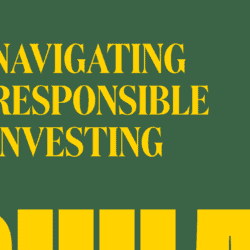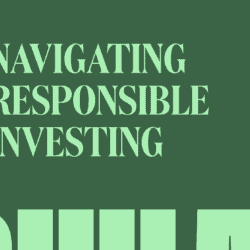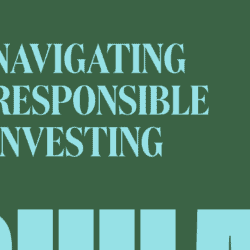Philanthropic foundations can manage their investments to provide much-needed support on the most urgent issues facing the planet in a variety of ways: divestment, transition financing combined with shareholder engagement, impact/ESG investment – or even winding down and freeing up their endowments to accelerate work toward a net-zero Canada by 2050.
When Bruce Lourie gained national attention last month by announcing that the Ivey Foundation will spend the next five years granting its entire $100-million endowment, he also had a message for Canada’s philanthropic foundations.
Many Canadian foundations are still consumed with building hospital wings and funding universities – laudable initiatives, the president of the Ivey Foundation tells The Philanthropist Journal. “But I think it is time for philanthropy, without dropping that work, to look at shifting the proportion of granting to things that are critical to the future of the world,” he says.
I absolutely hope more foundations take a look at what they are funding and come to the conclusion that there are some very, very important things in this country that are not being well supported.
Bruce Lourie, Ivey Foundation
Ivey is winding down over five years, and its funding is going to organizations that can help this country drastically reduce carbon emissions and meet its net-zero targets by 2050. The pace of climate transition must be accelerated, Lourie says, because the massive human tragedies wrought by climate change worldwide are only going to get worse while we grapple for solutions.
“I absolutely hope more foundations take a look at what they are funding and come to the conclusion that there are some very, very important things in this country that are not being well supported,” he says.
Lourie says $100 million is “a drop in the bucket” when it comes to the amount of money needed for climate transition and positioning Canadian industry to prosper in this new economy, but he says collaboration with other philanthropic organizations and non-governmental organizations will act as a multiplier beyond what Ivey can contribute.
Five years is needed to ensure the money can be properly managed by the foundation’s chosen donees, he says. He says that five to 10 years ago, there would not have been enough climate transition organizations to absorb $100 million over five years. Now he is comfortable in the knowledge that the change-makers are out there.
Lourie is taking one path, but for the philanthropic sector, there are many avenues to positive change.
There is divestment from high-emitting industries. Another strategy is transition financing, in which investments are made in those high emitters with a strategy to reduce carbon output. Those investments can be used as a means of pushing them along that road.
Shareholder engagement allows foundations to use both financial muscle and moral suasion to push entities, from banks to energy producers, toward net-zero goals. “Impact investing” or “ESG (environmental, social, and governance) investing” are defined by the Global Impact Investing Network (GIIN) as “investments made with the intention to generate positive, measurable social and environmental impact alongside a financial return.”
There is also “concessional investing,” a concept championed by the Trudeau government in its 2022 budget when it established the $15-billion Canada Growth Fund. The fund will accept lower returns – or even losses – in order to stimulate investment in green innovation and low-carbon projects that may not have the financial foundations to attract traditional investors as Ottawa aims for a net-zero 2050.
We believe the best way to accelerate the energy transition is by engaging with high emitters rather than passively divesting.
Jo Taylor, Ontario Teachers’ Pension Plan
Some of the boldest action on decarbonization transition is being done in the country’s pension sector, which is using its financial muscle. The Ontario Teachers’ Pension Plan will pour $5 billion into some of the world’s most notorious greenhouse gas emitters, then push strategies to reduce their carbon footprints.
“We believe the best way to accelerate the energy transition is by engaging with high emitters rather than passively divesting,” Ontario Teachers’ chief executive officer Jo Taylor said in a September speech at the Canadian Club in Toronto.
The Canada Pension Plan Investment Board ($523 billion in assets) has boasted that it used its leverage to attain better climate reporting and practices at 35 companies in 2022. Both pension funds decided that passive divestment was not yielding the needed results given the urgency of climate transition.
Sometimes companies need a push, says Éric St-Pierre, executive director of Montreal’s Trottier Family Foundation, which was founded in 2000 and in its early years did focus on universities and hospital wings. Starting in 2016 under St-Pierre’s leadership, its focus evolved to “catalyze and scale transformative innovations, create cross-sector collaborations, and take risks that others cannot.”
“We divested. That is one step,” St-Pierre says. But he believes the impact of divestment is unclear because while you are not investing, someone else might. “We always think we can go further.”
With shareholder engagement, we feel we can push companies to go a little bit further. They can listen, or they can ignore us, but as investors we have those tools.
Éric St-Pierre, Trottier Family Foundation
It’s one thing not to own shares in coal producers but another to ask yourself as a foundation what you can do with companies in which you have invested, he says. Part of the Trottier strategy is the more traditional impact investing and shareholder engagement.
“With shareholder engagement, we feel we can push companies to go a little bit further,” St-Pierre says. Trottier did just that with the Bank of Nova Scotia, filing a shareholder resolution with the bank requesting a more robust framework and better tool to measure how it would deal with “financed emissions,” the financing of clients with high emissions. They forged an agreement, but there is still work to be done. Trottier owns $2 million of Scotiabank stock, and it is using that leverage to prod Scotiabank for more clarity on how it will hit its 2030 climate targets.
“They can listen, or they can ignore us, but as investors we have those tools. We believe in collaboration,” St-Pierre says. “If they don’t listen, we can take the $2 million out, or we keep the shareholder resolution and take it to a vote at the AGM, something we would be quite public about.” The bank would then have to decide to accept or reject the Trottier proposal, but most likely it would not want to let it get to a vote. “Banks have been under a lot of scrutiny lately, and they should be sensitive about whether they want to go in that direction,” St-Pierre says. “They will work hard to ensure that these kinds of resolutions do not go to a vote.”
Trottier employs a three-pronged strategy that includes divestment, shareholder engagement, and impact investing, and Lisa Wolverton of The Philanthropy Workshop (TPW) Canada says all have their merits. She says TPW supports full asset allocation, which means its 400 global funders use all their resources on the social issues in their sphere, including traditional philanthropy, impact investing, and advocacy. TPW seeks to accelerate impact and ignite innovation.
If we don’t get increasingly engaged with climate change, we aren’t going to have universities or museums to enjoy.
Lisa Wolverton, The Philanthropy Workshop Canada
“Shareholder engagement is another tool that funders have in their toolkit to deploy towards improved social outcomes,” she says in an email. She shares Lourie’s sense of urgency on climate issues, however.
“We have a number of members from around the globe that are moving into a spend-down format, understanding this sense of urgency,” she says. “If we don’t get increasingly engaged with climate change, we aren’t going to have universities or museums to enjoy.”
Co-operators Community Funds (CCF) works with Addenda Capital, majority owned by the Co-Operators Group, on a strategy of investing in stocks of public companies that have mapped out a road to transition, then works with them to keep them on the road to meeting their carbon goals in a net-zero-by-2050 world. Addenda has created two transition pooled equity funds, one for Canada, one international.
CCF’s equity portfolio will shift toward public companies that are taking the necessary steps to reduce carbon emissions as an alternative to divestment, as Chad Park, vice-president of sustainability and citizenship at Co-Operators, and Greg Elliott, managing director of CCF, reported in a recent article.
Another example of transition financing is on display in southern Manitoba, where Trottier and three other foundations – the Lawson Foundation, the McConnell Foundation, and the Lundin Foundation – provided $2 million in a community-driven impact investment that is termed an “outcomes contract” by the project’s financial intermediary, Raven Indigenous Capital Partners. Raven is the only Indigenous financial intermediary in North America.
Jeff Cyr, who is of Métis and settler descent, is a co-founder of Raven. Cyr is a former negotiator for the Assembly of Manitoba Chiefs and had stints in four different federal government departments, including the Privy Council Office. He spent six years as executive director of the National Association of Friendship Centres, where he came to realize that innovation for Indigenous communities was just not funded well. After the Truth and Reconciliation Commission identified the need to do things differently, Cyr set out to counter the “deeply unconscious racism inside the mainstream capital system,” which led to the establishment of Raven four and a half years ago.
In a project that weds the transition to energy efficiency with the transition to Indigenous independence, geothermal units are being installed in on-reserve housing by Indigenous-owned non-profit Aki Energy. Work has been completed in an estimated 80% of the 124 homes in Peguis First Nation and Fisher River Cree Nation designated for the geothermal installations.
The rate of return for investors was pegged at a modest 4% because it was the first project of its kind in Canada and Cyr didn’t want to skew expectations. He was more interested in finding mission-aligned partners. “Capital return is a great thing, but we want people to do it for the right reasons – Indigenous energy sovereignty and [greenhouse gas] reductions. Those are more important fundamentally than capital rate of return.”
Foundations have the capacity to work in innovative and niche areas, but they don’t often do that. They have muscle memory on how to operate.
Jeff Cyr, Raven Indigenous Capital Partners
Other First Nations communities are now lined up for the same program, Cyr says, leading to Indigenous employment and skills training. It increases the value of the housing stock and delivers a healthy environment to those living in those communities. There are now plans to install the units in 400 more homes.
Raven has chosen to work in the areas of climate and Indigenous health, and the Aki project is seen as both transitioning to Indigenous sovereignty and transitioning houses to better energy efficiency and more resiliency, resulting in less demand on the energy grid and better health for residents.
“Foundations have the capacity to work in innovative and niche areas, but they don’t often do that,” Cyr says. “They have muscle memory on how to operate. If they are used to putting money in the stock market and getting a certain rate of return, it’s work for them to change their approach.”
Foundations need to step up and use their endowments in a less risk-averse way. They should be willing to lose money to effect change.
Jeff Cyr
Membership on foundation boards matters, he says. If your investment committee is made up of bankers, revolutionary ideas will prove elusive. “But I think it is starting to change,” he says. “Foundations need to step up and use their endowments in a less risk-averse way. They should be willing to lose money to effect change.”
There is a big difference in what foundations can do with their grant dollars as opposed to impact investing with their portfolios, Lourie says. “If you really want to make a difference on climate transition, it means taking your grant dollars and supporting organizations that are making these transitions happen. Help organizations that are going to change the rules of the capital market, rather than thinking that your capital is going to change the world. That is something that is being missed right now in philanthropy. It is using your grant dollars strategically to change the world.”
We are now seeing extraordinary opportunity – multiple Indigenous organizations working on every aspect of building projects, infrastructure, and decarbonizing communities. And that is a perfect place for philanthropic organizations to combine missions.
Bruce Lourie
Too many foundations feel that supporting climate transition means funding climate activists, and they see those activists throwing soup on paintings in art galleries and recoil, Lourie says. That is not climate transition, he says, and the sector has to get past this stereotype.
“We are now seeing extraordinary opportunity – fantastic opportunity – multiple Indigenous organizations working on every aspect of building projects, infrastructure, and decarbonizing communities. And that is a perfect place for philanthropic organizations to combine missions – important community social work with helping solve climate change,” he says.
St-Pierre, working with the Shareholder Association for Research and Education (SHARE), is trying to bring other foundations into the realm of shareholder engagement to accelerate transition. SHARE works with investors to steer their assets to paths that contribute to positive social and environmental outcomes. St-Pierre wants to bring as many as 20 foundations together and try to push their investment managers on shareholder engagement.
“When we got into this a couple of years ago, there were only a couple of foundations doing this, and today the number is the same,” he said. There is a lot of room for growth, he believes.
As for Lourie, he is at peace with the decision to wind down Ivey, a decision years in the making. The concept of foundations in perpetuity is being rightly questioned in philanthropy, he says, but the debate continues. The funding from a foundation first established in 1947 will go to the likes of the Transition Accelerator, the Canada Climate Law Initiative, the Canadian Centre for Energy Information, and other organizations focused on planning for energy transition.
“We all feel super good about it,” he says. “I think the work we’ve done in the past 10 years has built up a lot of organizations that we now feel are well positioned to move us on the climate agenda in a way that we never have before in Canada. You put all the pieces together, it really made sense to us.”


